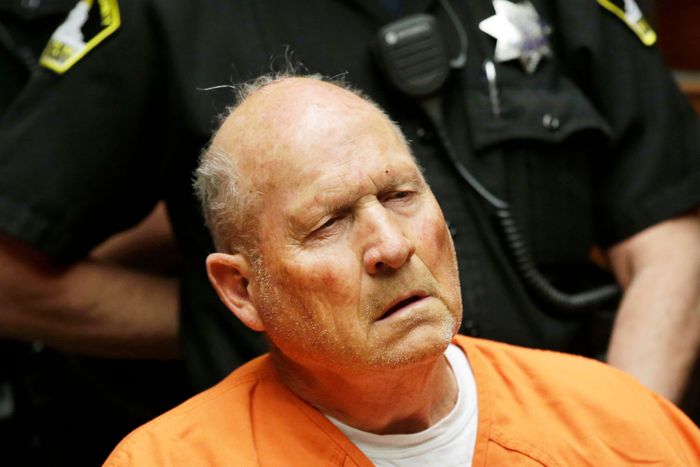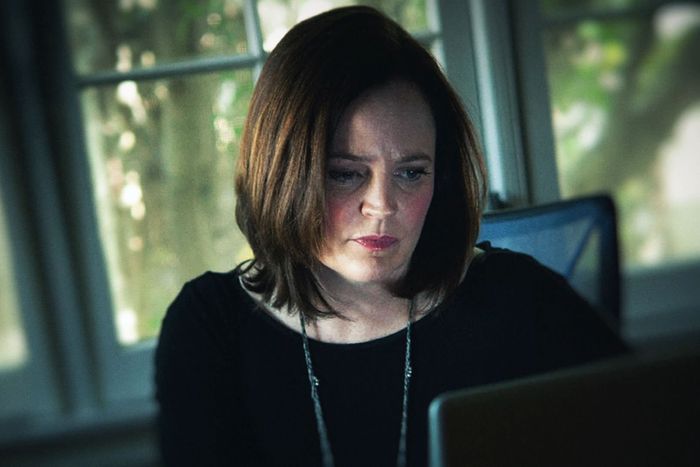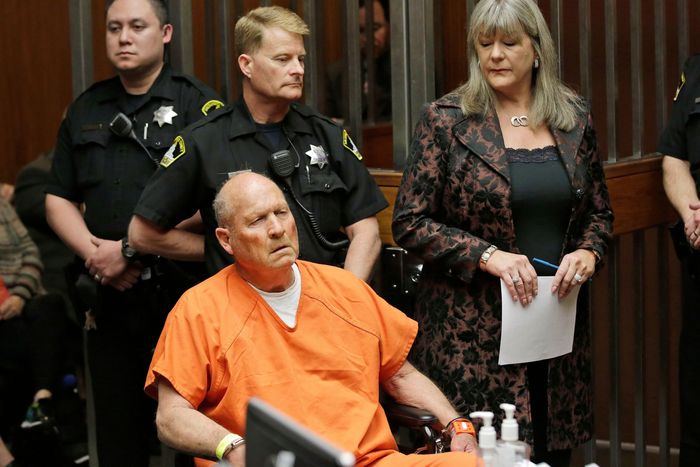
HBO’s new six-part documentary I’ll Be Gone in the Dark tells the forever-intertwined stories of late author Michelle McNamara and Joseph James DeAngelo, the man she dubbed the Golden State Killer. DeAngelo, 74, pleaded guilty on June 29 to 13 counts of murder, a deal that will see him serve life without parole and avoid the death penalty. He also admitted guilt to over 50 rapes and a slew of burglaries throughout California in the ’70s and ’80s, though he won’t face charges for those crimes due to statutes of limitations.
It’s eerie timing considering the first episode of I’ll Be Gone in the Dark premiered the night before DeAngelo’s plea. The documentary, directed by Liz Garbus, focuses on McNamara’s work as a true-crime writer who became obsessed with the case and died in 2016 of a fatal mix of prescription medications while working on a book about it. That book, also titled I’ll Be Gone in the Dark, was finished posthumously by her husband, comedian Patton Oswalt, and two of McNamara’s colleagues. It became a best seller in 2018, released just two months before police finally caught DeAngelo using an online familial DNA database, a tactic McNamara had suggested to the detectives working on the case after trying the popular 23andMe service.
For those unfamiliar with McNamara’s life and work or the Golden State Killer, a moniker she created while researching his crimes, here’s a primer on their stories and how they converged. If you’re planning to watch I’ll Be Gone in the Dark, know that the documentary doesn’t present this story in such chronological order, instead interweaving details of the Golden State Killer case with McNamara’s investigation to figure out his identity.
The Killer
Joseph James DeAngelo was born in 1945, the son of an Army sergeant. Before his family ultimately settled in California, they spent time at an Air Force base in West Germany where DeAngelo witnessed his 7-year-old sister’s rape by two servicemen, according to her son. According to the documentary, their father locked DeAngelo and his siblings in closets, forced them to eat food off the floor, and beat them, with Joseph receiving the brunt of the violence.
DeAngelo later served in the Navy during Vietnam, working as a damage-control man on a warship, then enrolled at Sierra College, a community college in Rocklin, California, to study police science. There, he met Bonnie Colwell, who describes him in the documentary as being sexually aggressive and pushing her to join him on illegal hunting trips. They got engaged in 1970, but she broke it off when he asked her to help him cheat in his abnormal psychology class.
In a story Colwell recounted in the Los Angeles Times podcast The Man in the Window, a few nights after the split she woke up to DeAngelo rapping at her bedroom window, pointing a gun at her, and demanding she go with him to Reno to elope. She ran to her father, who told her to hide in the bathroom while he talked DeAngelo down. The incident was never reported to the police, and Colwell believes it’s because her father might have wanted to protect DeAngelo’s chances at joining the force.
It’s theorized that this might have been DeAngelo’s breaking point, as during one of his subsequent sexual assaults, the victim reported her attacker saying, “I hate you, Bonnie!” As Man in the Window recounts, within the year of their split, there were nearby reports of a peeping tom and cat burglar who’d stare into windows while not wearing pants, crawl inside to touch women as they slept, and kill families’ dogs.
In 1973, DeAngelo married Sharon Huddle and became a police officer assigned to the burglary unit in Exeter, a year before a serial robber started a spree of crimes in the neighboring town of Visalia. The Visalia Ransacker had the same MO as the Rancho Cordova burglar, with investigators noting that he would scale fences, pry open windows or sliding doors, and use trails and ditches to enter and exit the crime scenes. In 1975, DeAngelo shot and killed a college professor, Claude Snelling, who’d discovered the criminal attempting to kidnap his daughter. That same year, the Ransacker was detained by a detective and feigned surrender, only to shoot and wound the cop before escaping. All told, he committed approximately 120 robberies and break-ins in under two years.
In June 1976, DeAngelo committed his first confirmed rape, one of 50 sexual assaults that would take place in the Sacramento region over the next three years, leading him to be dubbed the East Area Rapist, or EAR, by a local paper. Many victims later reported that they’d suspected their homes had been broken into beforehand, with DeAngelo unlocking windows and doors, and leaving behind ropes, shoelaces, and other bindings. He started by targeting women home alone then escalated to attacking couples, ordering the woman to bind her male companion, then stacking plates on the man’s back, and saying that he’d kill them if he heard them fall over. The assaults could last for hours, with the mask-wearing DeAngelo taking food and beer from their fridges, stealing photos and keepsakes, and sometimes calling his victims afterward to viciously taunt them.
The first murders during this era of DeAngelo’s crime spree occurred in February 1978. Brian and Katie Maggiore were out walking their dog in Rancho Cordova when they encountered him, possibly in the midst of breaking into or leaving a home. Whatever argument transpired, they fled and DeAngelo shot them. At the time, the case was suspected to be linked to the rapes, a fact later confirmed by DNA evidence. By the time of the last EAR attack in July 1979, DeAngelo was working at the Auburn Police Department and was fired from the job after getting arrested for shoplifting a hammer and a can of dog repellent.
At this point, DeAngelo escalated to being a full-on serial killer, moving his spree to Southern California, presumably to vary his patterns and avoid detection. He was nearly caught once: In the midst of attacking a couple in Goleta, Santa Barbara County, the woman screamed, causing DeAngelo to flee on a bicycle. An FBI-agent neighbor pursued DeAngelo, but lost him as he hopped a fence. The shoe prints DeAngelo left behind would tie him to his first known murder in the region, the December ’79 shootings of Robert Offerman and Debra Manning. DeAngelo killed seven more people over the next two years, usually raping the women and bludgeoning his victims to death with various objects, including a fireplace log. Only one victim, Manuela Witthuhn, was home alone, as her husband was hospitalized at the time.
DeAngelo didn’t kill again until the 1986 slaying of 18-year-old Janelle Cruz. The yearslong gap between the murders is attributed to DeAnglo becoming a father and taking in his young cousin for a time. Long after the Cruz homicide, police dubbed him the Original Night Stalker when they realized his slayings occurred before that of Richard Ramirez, whom the press dubbed the Night Stalker for a series of rapes and murders in 1984 and ’85. When DeAngelo’s crimes were finally linked by DNA in 2001, he became known as EAR/ONS, an awkward acronym that would stick until McNamara called him the Golden State Killer in her 2013 Los Angeles magazine article, “In the Footsteps of a Killer.”
From that point on, DeAngelo committed no crimes outside of a 1996 arrest for stealing from a gas station. He lived in Citrus Heights, worked as a truck mechanic until his 2017 retirement, and was known as a strange man who’d scream profanities in his backyard and once threatened to kill a neighbor’s dog for barking too loud. “If you don’t shut that dog up, I’ll deliver a load of death,” DeAngelo said in a voice-mail, the neighbor recounted in 2018.
The Writer
Michelle McNamara was born in 1970 and grew up in Oak Park, Illinois, the youngest of six children. Her fascination with crime began in her teens with the still-unsolved 1984 murder of a local woman, Kathy Lombardo. In a 2012 blog post titled “Origin Story,” McNamara described visiting the crime scene and picking up pieces of Lombardo’s shattered yellow Walkman, writing, “Never again would I tune out when the words ‘homicide’ or ‘missing’ or ‘mystery’ came on the news.”
After graduating from Notre Dame and getting her MFA in creative writing from Minnesota, she moved to Los Angeles, where she met Oswalt in 2003. The couple wed in 2005 and gave birth to their daughter, Alice, in 2009. In 2006, she launched the site True Crime Diary, which featured her lyrical, personal writings on unsolved cases that fascinated her and pulled her to become part of the “citizen detective” world. This mostly online community involves amateurs who pore over police records, newspaper clippings, message boards, and whatever else they can use to solve cases. Some are borderline conspiracy theorists, while others take it seriously — and have solved multiple homicides and other mysteries over the years, finding overlooked details or using the power of social media to crowdsource tips.
McNamara’s interest in the EAR/ONS case started with the 2010 book Sudden Terror by Larry Crompton, a retired detective from the Contra Costa County Sheriff’s Department who investigated DeAngelo’s original rapes. McNamara soon started looking into the case on her own, visiting crime scenes and talking with witnesses and the police who handled the case. She gained the detectives’ respect by finding a pair of cuff links on eBay that matched the description of ones DeAngelo had stolen from a victim. The lead didn’t pan out, but they accepted her as someone who knew her stuff.
In her Los Angeles magazine story — the one in which she decided EAR/ONS should be called the Golden State Killer because “at the very least, this ID is more memorable” — McNamara shared evidence that was never publicly available before and garnered plenty of new attention on DeAngelo’s crimes. The article was such a sensation that it eventually turned into a book deal, which led her deeper into her obsession with finding the killer. With the help of citizen investigator Paul Haynes, she was able to access dozens of boxes of files on the case, while professional detectives Larry Pool, Paul Holes, and Crompton, among others, kept in regular contact with her to discuss leads and theories.
Tragically, the pressure of the book’s deadlines and the nightmare-inducing stressors of looking into the Golden State Killer case led McNamara to self-medicate. She used Adderall to focus and Xanax to sleep, and eventually started using opioids, a habit nobody close to her detected. Her friends and family thought she was just worn out, understandably so, as seen in the HBO documentary’s use of heartbreaking text messages between her and Oswalt. In one sleepless night, she wrote a chapter, “Letter to an Old Man,” in which she imagined how DeAngelo would be caught: “‘You’ll be silent forever, and I’ll be gone in the dark,’ you threatened a victim once. Open the door. Show us your face. Walk into the light.”
McNamara died on April 21, 2016, from what an autopsy report determined to be an accidental overdose.
The Aftermath
While still in the throes of grief, Oswalt decided that McNamara’s book needed to be finished, so he enlisted the help of Haynes and Billy Jensen, himself an author and citizen detective. Using her detailed notes and outlines, they pressed on with both the investigation and writing, eventually publishing the book in February 2018.
In one section, McNamara postulated that using a 23andMe-style genetic database, as she’d used herself for fun, would be a way to catch the killer, figuring the popularity of these services would lead to someone in his family to have tried it out. Holes, an investigator for Contra Costa County with a background in biochemistry, agreed and eventually uploaded DNA samples to the public database GEDmatch.
What Holes and his colleagues found were a number of people who had the same great-great-great-grandparents as the killer. They meticulously narrowed down the list, searching every record they could find to create family trees, trying to find a male relative who might fit the description of the killer and match up with the time line and locations of the crimes. After multiple dead ends, they found DeAngelo in April 2018.
Everything seemed to fit: the physical attributes, the locales, the background in law enforcement. So, the detectives first obtained a sample of DeAngelo’s DNA from the door handle of his car. It wasn’t perfectly accurate, as many people could’ve possibly touch that same surface, but it was close enough that they were confident they had their man. Then, after testing a discarded tissue that they found in DeAngelo’s trash, they got their confirmation — a 100 percent DNA match.
DeAngelo was arrested on April 24, 2018. He was charged with only the Maggiore murders at first, while the various jurisdictions figured out how to proceed and what was prosecutable under statutes of limitations. As the documentary shows, Oswalt, Jensen, and Haynes were in Chicago at the time, trading late-night messages after first getting a tip that the Golden State Killer had finally been caught. “I think you got him, Michelle,” Oswalt tweeted the next morning. Later that day, when police at the press conference denied that McNamara’s work helped, Oswalt wrote, “It did, but #MichelleMcNamara didn’t care about getting any shine on herself. She cared about the #GoldenStateKiller being behind bars and the victims getting some relief.”
D’Angelo eventually appeared in court, cuffed in a wheelchair, looking feeble in front of many of his victims. As Rolling Stone reported, many of the women gasped when they heard him speak, recognizing his voice all these years later. Over the next two years, prosecutors added the remaining 11 murder charges, sought the death penalty, and hammered out the plea deal that will put the 74-year-old Golden State Killer in prison for the rest of his life. On June 29, 2020, DeAngelo officially pleaded guilty to all 13 murders with which he was charged and admitted guilt to the rapes and burglaries that he can no longer be held accountable for, due to statutes of limitations. He was sentenced to 11 consecutive life terms without the possibility of parole, among other punishments.
Sitting in a wheelchair and wearing a protective mask due to the COVID-19 pandemic, DeAngelo repeatedly rasped “guilty” and “I admit,” looking frail with his mouth often hanging open while the details of his crimes were read. One of the many prosecutors involved in the hearing — one each from the six counties where he committed his crimes — pointed out that DeAngelo was seen lifting heavy objects and racing on his motorcycle in the days prior to his arrest and that he’d previously feigned insanity when he was caught shoplifting in 1979, insinuating that the 74-year-old was overplaying his diminished state to avoid any further accountability to the many victims in the courtroom. He is expected to be officially sentenced in August.
As McNamara wrote in her letter to the man she chased, but never got to see brought to justice, “This is how it ends for you.”







